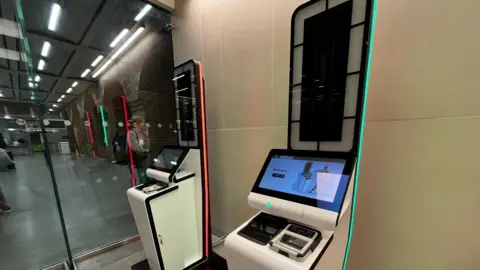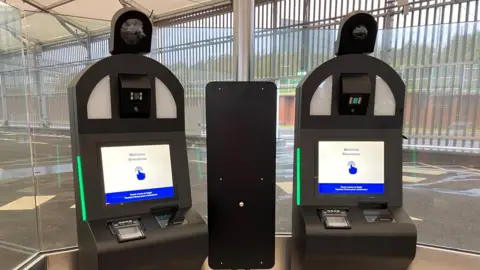Katy AustinTransport correspondent
 BBC
BBCThe next time you travel from the UK to Europe, you might notice some changes.
The EU’s much-delayed new digital border system, the Entry/Exit System or EES, will be gradually introduced this autumn.
The system is meant to strengthen security and ultimately make travel smoother, but there have been concerns there will be queues when people first register.
What is EES and where is it being introduced?
EES is a digital system designed to keep track of when non-EU citizens enter and leave the Schengen Area.
This covers 29 European countries – mainly in the EU – which people can travel across without border controls.
It includes many popular destinations for UK travellers, such as France, Spain, Portugal, Italy and Greece.
Under the new system, fingerprints and a photo have to be registered.
EES will eventually replace the current system of passports being stamped by a border officer.
When will EES start?
After being postponed several times, the European Commission confirmed in July that EES will begin on 12 October.
It will be gradually phased in over six months.
That means when you first encounter EES will depend where you’re travelling to, and when.
At Dover, ferry passengers in coaches will start using the new system on 12 October, followed by other tourist traffic on 1 November.
At Eurostar terminals, only a small number of business travellers will be invited to use it from 12 October. More passengers will be directed to it over the coming months.
Eurotunnel, which runs vehicle shuttles through the Channel Tunnel, will also introduce EES in stages from 12 October.
Only Eurotunnel’s coach passengers and freight will do the new checks to start with. They will be done by a border officer, so not much will change.
Tourists in cars will start using automated kiosks by the end of the year. The company hasn’t given an exact date.
Different airports are likely to bring in EES at different times – it’s a very mixed picture. But after a slow start, the number using it should gradually increase over the coming months.
EES should be active at every Schengen border crossing point in all 29 participating countries by 10 April 2026.
What will passengers have to do under EES?
The first time they use the new system, people from most non-EU countries – including the UK – will have to register biometric information while having their passport scanned.
This may be done with a border officer, or at an automated machine, depending on where people travel to.
Flight passengers will register when they arrive at their destination airport.
But registration will be done as you leave the UK if you are crossing the English Channel by ferry from the port of Dover, taking the Eurotunnel shuttle to France, or getting the Eurostar train.
At these places, most passengers will have to follow the instructions at special kiosks.
The machines will scan each passport, then take fingerprints and a photo.
Children under 12 won’t have to provide fingerprints. Staff should be on hand to help.
The screen will also present travellers with four questions about their trip, such as confirming where they will be staying and that they have enough money.
However, at Eurotunnel, those questions will be asked by border officers, on a discretionary basis.
The port of Dover has had to make big changes. It has reclaimed some land from the sea to create an additional processing area.
People will head to this new area, a mile from the ferry terminal, to do their EES checks.
Because the French border has in effect been moved to a coach processing building in this new area, coaches will be sealed after passengers have completed their checks. They will then drive over to catch their ferry.
The port’s boss says groups of schoolchildren will be able to do some of their registration in advance, so they will only need to present their passports at the border.

Eurostar has installed 49 EES kiosks in three areas around its London St Pancras terminal. Passengers will use them before presenting their ticket at the departures area.
But it says all passports will continue to be stamped manually until EES is fully rolled out in 2026.
Eurotunnel has installed more than a hundred kiosks at each side of the Channel.
Customers who are travelling in cars will be directed to drive up to a kiosk bearing their registration number, and provide their biometric information there. Coach passengers will go through the process with a border officer.

A mobile phone app has been developed to enable passengers to do part of the process before reaching the border. However, this won’t be widely used when EES is first introduced.
The EES registration will be valid for three years, with the details verified on each trip during that period.
What are the concerns about the introduction of EES?
Concerns have repeatedly been raised that the extra couple of minutes it takes for each traveller to complete the registration process could lead to big queues, particularly at space-constrained Dover.
However, bosses at cross-Channel travel hubs hope that the decision to introduce EES gradually, instead of with a “big bang” start, will reduce the risk of disruption.
Eurotunnel chief executive Yann Leriche says there will be no “chaos” or queues at the Channel tunnel, insisting his company has done extensive modelling and is fully prepared.
Similarly, Eurostar hopes its decision to limit EES initially to some business travellers before expanding its use will help prevent queues.
What is ETIAS and when is that coming?
The EU is also introducing a new visa waiver system linked to passports called the European Travel Information and Authorisation System (ETIAS), which will build on the EES.
Citizens of non-EU countries who don’t need a visa to enter the EU – including people from the UK – will be able to apply online for authorisation before they travel.
ETIAS isn’t due to start until the end of 2026, but the final date has not yet been confirmed.
It will cost €20 (£17.47) per application, and will be valid for three years.
People aged under 18 and over 70 will need to apply, but won’t have to pay.



